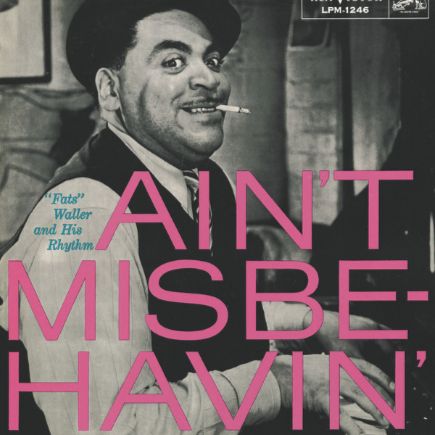Ain’t Misbehavin’: Fats Waller, Harlem et l’affirmation d’un art
Composée en 1929 par Fats Waller et Harry Brooks, sur des paroles d’Andy Razaf, Ain’t Misbehavin’ est bien plus qu’un simple succès musical: elle incarne l’esprit foisonnant de la Harlem Renaissance. Pensée comme numéro d’ouverture de la revue Connie’s Hot Chocolates, produite au Connie’s Inn — principal rival du Cotton Club —, elle célèbre l’inventivité afro-américaine dans un contexte de profonde effervescence artistique.
La chanson séduit par la combinaison d’une mélodie accrocheuse et d’harmonies sophistiquées, typiques du style stride dont Waller était l’un des maîtres incontestés. À travers un texte sur la fidélité amoureuse face aux tentations, Ain’t Misbehavin’ trouve une résonance universelle et intemporelle, renforçant son pouvoir d’attraction bien au-delà de son époque.
Son destin bascule lorsqu’un jeune Louis Armstrong est invité à doubler l’orchestre de Leroy Smith pour jouer au Hudson Theater. Son interprétation entre les actes, d’abord discrète depuis la fosse, devient rapidement le point culminant du spectacle. Un critique du New York Times souligne la puissance de ce moment, décrivant la chanson comme ‘synthétique, mais tout à fait agréable’. Armstrong est alors officiellement intégré à la distribution: sa prestation, désormais sur scène, propulse sa carrière vers une reconnaissance nationale.
Fats Waller et l’immortalité d’Ain’t Misbehavin’
Le 2 août 1929, Fats Waller enregistre à New York l’une de ses interprétations les plus mémorables: Ain’t Misbehavin’. Cette mélodie incarne l’élégance du jazz de Harlem et l’esprit insouciant de l’ère du swing naissant. Le titre, déjà popularisé par Louis Armstrong sur scène, trouve sous les doigts de Waller une profondeur singulière où se mêlent humour, virtuosité et raffinement.
L’enregistrement de 1929 illustre l’art du stride piano de Waller: son jeu, bâti sur une main gauche puissante et une main droite d’une agilité remarquable, confère à la pièce une dynamique irrésistible. La voix chaleureuse de Waller, empreinte de malice, donne à la chanson une légèreté teintée de sophistication qui séduira autant les amateurs de jazz que le grand public.
Plus qu’un simple succès populaire, Ain’t Misbehavin’ devient un symbole de l’âge d’or du Cotton Club et de la diffusion du jazz dans les cabarets et les premiers enregistrements radiophoniques. Son interprétation par Waller témoigne d’un moment charnière où le jazz s’ouvre à une audience plus large, tout en conservant l’empreinte inventive et expressive de ses créateurs afro-américains.
Ain’t Misbehavin’: Fats Waller, Harlem y la afirmación de un arte
Compuesta en 1929 por Fats Waller y Harry Brooks, con letra de Andy Razaf, Ain’t Misbehavin’ es mucho más que un éxito musical: encarna el espíritu vibrante del Renacimiento de Harlem. Concebida como número de apertura de la revista Connie’s Hot Chocolates, producida en el Connie’s Inn — principal competidor del Cotton Club —, celebra la inventiva afroamericana en un momento de intensa efervescencia artística.
La canción destaca por su combinación de melodía pegadiza y armonías sofisticadas, características del estilo stride que Waller dominaba con maestría. Su letra, centrada en la fidelidad amorosa frente a las tentaciones, le confiere una resonancia universal y atemporal, lo que ha contribuido a consolidar su atractivo a lo largo de las décadas.
Su destino cambia cuando un joven Louis Armstrong es invitado a reforzar la orquesta de Leroy Smith en el Hudson Theater. Su interpretación durante los intermedios, inicialmente desde el foso, se convierte pronto en el punto culminante del espectáculo. Un crítico del New York Times destacó la fuerza de ese momento, describiendo la canción como “sintética, pero francamente agradable”. Armstrong es entonces integrado oficialmente en el reparto, y su actuación sobre el escenario lanza su carrera hacia el reconocimiento nacional.
Fats Waller y la inmortalidad de Ain’t Misbehavin’
El 2 de agosto de 1929, Fats Waller grabó en Nueva York una de sus interpretaciones más memorables: Ain’t Misbehavin’. Esta melodía encarna la elegancia del jazz de Harlem y el espíritu desenfadado de la naciente era del swing. El tema, ya popularizado en escena por Louis Armstrong, adquiere bajo los dedos de Waller una profundidad singular, en la que se entrelazan humor, virtuosismo y refinamiento.
La grabación de 1929 ilustra el arte del stride piano de Waller: su estilo, construido sobre una mano izquierda poderosa y una mano derecha de agilidad extraordinaria, otorga a la pieza una energía irresistible. Su voz cálida, impregnada de picardía, añade una ligereza sofisticada que seduce tanto a los amantes del jazz como al público en general.
Más que un simple éxito popular, Ain’t Misbehavin’ se convierte en un símbolo de la edad de oro del Cotton Club y de la expansión del jazz en los cabarés y las primeras emisiones radiofónicas. La interpretación de Waller refleja un momento decisivo en el que el jazz se abre a una audiencia más amplia, manteniendo siempre la impronta inventiva y expresiva de sus creadores afroamericanos.
Ain’t Misbehavin’: Fats Waller, Harlem e l’affermazione di un’arte
Composta nel 1929 da Fats Waller e Harry Brooks, con testo di Andy Razaf, Ain’t Misbehavin’ è molto più di un successo musicale: rappresenta lo spirito vivace della Harlem Renaissance. Pensata come apertura della rivista Connie’s Hot Chocolates, andata in scena al Connie’s Inn — principale concorrente del Cotton Club —, celebra l’ingegno afroamericano in un contesto di grande fermento artistico.
Il brano conquista per l’efficace combinazione tra melodia accattivante e armonie raffinate, tipiche dello stile stride che Waller padroneggiava in modo magistrale. Il testo, incentrato sulla fedeltà amorosa nonostante le tentazioni, le conferisce una forza espressiva universale e senza tempo, che ne ha garantito la longevità.
La svolta arriva quando un giovane Louis Armstrong viene invitato a rinforzare l’orchestra di Leroy Smith al Hudson Theater. La sua esecuzione tra un atto e l’altro, inizialmente dal golfo mistico, diventa presto il momento clou dello spettacolo. Un critico del New York Times sottolineò la potenza di quel passaggio, definendo la canzone “sintetica, ma assolutamente gradevole”. Armstrong viene così inserito ufficialmente nel cast, e la sua performance sul palco segna l’inizio della sua ascesa a livello nazionale.
Fats Waller e l’immortalità di Ain’t Misbehavin’
Il 2 agosto 1929, Fats Waller incise a New York una delle sue interpretazioni più memorabili: Ain’t Misbehavin’. Questa melodia incarna l’eleganza del jazz di Harlem e lo spirito spensierato dell’epoca nascente dello swing. Il brano, già reso celebre sul palcoscenico da Louis Armstrong, trova sotto le dita di Waller una profondità unica, dove si fondono umorismo, virtuosismo e raffinatezza.
La registrazione del 1929 illustra l’arte dello stride piano di Waller: il suo stile, costruito su una mano sinistra potente e una destra di straordinaria agilità, conferisce al pezzo un’energia irresistibile. La voce calda di Waller, intrisa di malizia, dona alla canzone una leggerezza sofisticata capace di conquistare tanto gli appassionati di jazz quanto il grande pubblico.
Più che un semplice successo popolare, Ain’t Misbehavin’ diventa un simbolo dell’età d’oro del Cotton Club e della diffusione del jazz nei cabaret e nelle prime trasmissioni radiofoniche. L’interpretazione di Waller testimonia un momento cruciale in cui il jazz si apre a un pubblico più vasto, mantenendo intatta l’impronta inventiva ed espressiva dei suoi creatori afroamericani.
Ain’t Misbehavin’: Fats Waller, Harlem, and the assertion of an art form
Composed in 1929 by Fats Waller and Harry Brooks, with lyrics by Andy Razaf, Ain’t Misbehavin’ is far more than a popular hit — it captures the dynamic spirit of the Harlem Renaissance. Originally conceived as the opening number for the revue Connie’s Hot Chocolates, staged at Connie’s Inn — the main rival of the Cotton Club — the piece celebrates African American creativity during a time of profound artistic vitality.
The song captivates through its blend of catchy melody and sophisticated harmonies, hallmarks of the stride piano style that Waller mastered like few others. Its lyrics, centered on romantic fidelity in the face of temptation, carry a timeless and universal resonance, lending the piece lasting relevance.
Its trajectory shifted dramatically when a young Louis Armstrong was asked to reinforce Leroy Smith’s orchestra at the Hudson Theater. His intermission performance — initially delivered from the orchestra pit — quickly became the highlight of the evening. A New York Times critic noted the impact of the moment, calling the song “synthetic but thoroughly enjoyable.” Armstrong was soon officially added to the cast, and his stage performance marked the beginning of his rise to national fame.
Fats Waller and the immortality of Ain’t Misbehavin’
On August 2, 1929, Fats Waller recorded in New York one of his most memorable performances: Ain’t Misbehavin’. This melody embodies the elegance of Harlem jazz and the carefree spirit of the emerging swing era. Already popularized on stage by Louis Armstrong, the piece took on a unique depth under Waller’s hands, blending humor, virtuosity, and refinement.
The 1929 recording showcases the art of stride piano of Waller: his style, built on a powerful left hand and an exceptionally agile right, gives the piece an irresistible drive. Waller’s warm voice, laced with mischief, adds a touch of sophistication and lightness that appeals to both jazz aficionados and the broader public.
More than just a popular hit, Ain’t Misbehavin’ became a symbol of the Cotton Club’s golden age and the spread of jazz through cabarets and early radio broadcasts. Waller’s interpretation captures a pivotal moment when jazz opened itself to a wider audience while preserving the inventive and expressive imprint of its African American creators.


